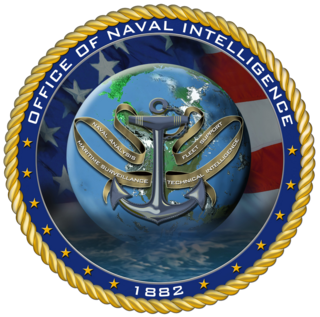Related Research Articles

USS Oldendorf (DD-972), named for Admiral Jesse B. Oldendorf USN, was a Spruance-class destroyer built by the Ingalls Shipbuilding Division of Litton Industries at Pascagoula, Mississippi.

USS Blue Ridge (LCC-19) is the lead ship of the two Blue Ridge-class amphibious command ships of the United States Navy, and is the flagship of the Seventh Fleet. Her primary role is to provide command, control, communications, computers, and intelligence (C4I) support to the commander and staff of the United States Seventh Fleet. She is currently forward-deployed to U.S. Navy Fleet Activities, Yokosuka in Japan, and is the third Navy ship named after the Blue Ridge Mountains, a range of mountains in the Appalachian Mountains of the eastern United States. Blue Ridge is the oldest deployed warship of the U.S. Navy, following the decommissioning of USS Denver. Blue Ridge, as the U.S. Navy's active commissioned ship having the longest total period as active, flies the First Navy Jack instead of the jack of the United States. Blue Ridge is expected to remain in service until 2039.
OP-20-G or "Office of Chief Of Naval Operations (OPNAV), 20th Division of the Office of Naval Communications, G Section / Communications Security", was the U.S. Navy's signals intelligence and cryptanalysis group during World War II. Its mission was to intercept, decrypt, and analyze naval communications from Japanese, German, and Italian navies. In addition OP-20-G also copied diplomatic messages of many foreign governments. The majority of the section's effort was directed towards Japan and included breaking the early Japanese "Blue" book fleet code. This was made possible by intercept and High Frequency Direction Finder (HFDF) sites in the Pacific, Atlantic, and continental U.S., as well as a Japanese telegraphic code school for radio operators in Washington, D.C.

The Office of Naval Intelligence (ONI) is the military intelligence agency of the United States Navy. Established in 1882 primarily to advance the Navy's modernization efforts, it is the oldest member of the U.S. Intelligence Community and serves as the nation's premier source of maritime intelligence.

Insignias and badges of the United States Navy are military badges issued by the United States Department of the Navy to naval service members who achieve certain qualifications and accomplishments while serving on both active and reserve duty in the United States Navy. Most naval aviation insignia are also permitted for wear on uniforms of the United States Marine Corps.

Imperial Japanese Naval Landing Forces or Imperial Japanese Marines were marines units in the Imperial Japanese Navy (IJN) organized for offensive operations and for the defense of Japanese naval facilities both overseas and in the Japanese home islands.

A spy ship or reconnaissance vessel is a dedicated ship intended to gather intelligence, usually by means of sophisticated electronic eavesdropping. In a wider sense, any ship intended to gather information could be considered a spy ship.

Cryptologic technician (CT) is a United States Navy enlisted rating or job specialty. The CT community performs a wide range of tasks in support of the national intelligence-gathering effort, with an emphasis on cryptology and signal intelligence related products.

A United States Navy diver refers to a service personnel that may be a restricted fleet line officer, civil engineer corps (CEC) officer, Medical Corps officer, or an enlisted who is qualified in underwater diving and salvage. Navy divers serve with fleet diving detachments and in research and development. Some of the mission areas of the Navy diver include: marine salvage, harbor clearance, underwater ship husbandry and repair, submarine rescue, saturation diving, experimental diving, underwater construction and welding, as well as serving as technical experts to the Navy SEALs, Marine Corps, and Navy EOD diving commands.

Radioman (RM) was a rating for United States Navy and United States Coast Guard enlisted personnel, specializing in communications technology.

The United States Marine Corps is organized within the Department of the Navy, which is led by the Secretary of the Navy (SECNAV). The most senior Marine commissioned officer is the Commandant of the Marine Corps, responsible for organizing, recruiting, training, and equipping the Marine Corps so that it is ready for operation under the command of the unified combatant commanders. The Marine Corps is organized into four principal subdivisions: Headquarters Marine Corps, the Operating Forces, the Supporting Establishment, and the Marine Forces Reserve.
The structure of the United States Navy consists of four main bodies: the Office of the Secretary of the Navy, the Office of the Chief of Naval Operations, the operating forces, and the Shore Establishment.

USS Gold Star (AK-12) was a U.S. Navy cargo ship that saw service before and during World War II. She was responsible for delivering necessary goods and equipment to ships and stations in the war zone.

The Operational Test and Evaluation Force (OPTEVFOR) is an independent and objective agency within the United States Navy for the operational testing and evaluation (OT&E) of naval aviation, surface warfare, submarine warfare, C4I, cryptologic, and space systems in support Navy and Department of Defense acquisition programs.
The United States Marine Corps's Advanced Base Force was a coastal and naval base defense force that was designed to set up mobile and fixed bases in the event of major landing operations within, and beyond, the territorial United States. Established in the beginning of the 20th century, the Advanced Base Force was the United States' first combined task force built on the concept of the Marine Corps' traditional role in expeditionary warfare. The slow development of the advanced base force played a significant role in the controversy over the removal of the ships' guards in 1908–1909.

The United States Navy (USN) is the maritime service branch of the United States Armed Forces and one of the eight uniformed services of the United States. It is the world's most powerful navy and the largest by tonnage, at 4.5 million tons in 2021 and in 2009 an estimated battle fleet tonnage that exceeded the next 13 navies combined. It has the world's largest aircraft carrier fleet, with 11 in service, 1 undergoing trials, two new carriers under construction, and six other carriers planned as of 2024. With 336,978 personnel on active duty and 101,583 in the Ready Reserve, the U.S. Navy is the third largest of the United States military service branches in terms of personnel. It has 299 deployable combat vessels and about 4,012 operational aircraft as of July 18, 2023.

Information systems technician (IT) is a rating for United States Navy and United States Coast Guard enlisted personnel, specializing in communications technology. Information systems technician submarines (ITS) is a rating for U.S. Navy submariners. The Information systems technician (IT) rating corresponds to the new Navy Occupational Specialty (NOS) code B460 while the information systems technician submarines (ITS) rating corresponds to Navy Occupational Specialty (NOS) code C260.
The Radio Materiel School (RMS) was the first electronics training facility of America’s military organizations. Operated by the United States Navy, it produced during the 1920s and 1930s the core of senior maintenance specialists for the Navy’s communication equipment, that according to USN fleet admiral Chester W. Nimitz “paved the way to United States world leadership in electronics.”
The German Naval Intelligence Service was the naval intelligence department of the Germany Navy and had a long history, going back to the naval aspirations of German emperor Wilhelm II in 1899.
References
- ↑ "The "On-The-Roof" Gang". September 20, 2010. Retrieved May 18, 2012.
- ↑ "Pearl Harbor Review - The On-The-Roof Gang". January 15, 2009. Retrieved May 18, 2012.
- ↑ Whitlock, Duane L. (1995). "The Silent War against the Japanese Navy". Naval War College Review. XLVIII (4).